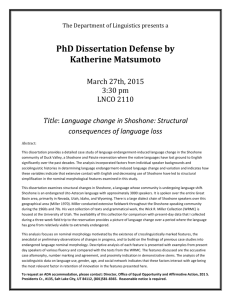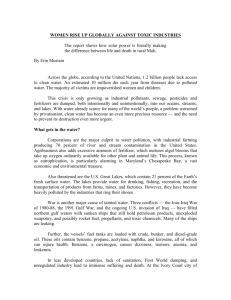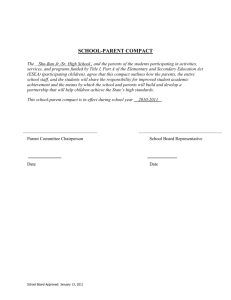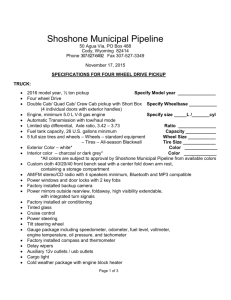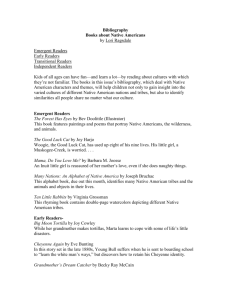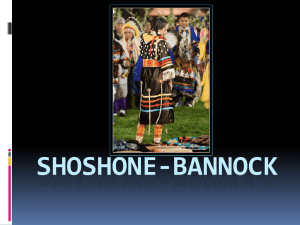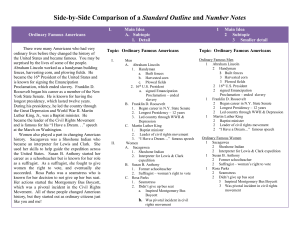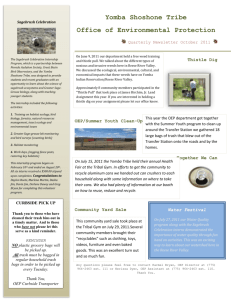Report from Amnesty International
advertisement
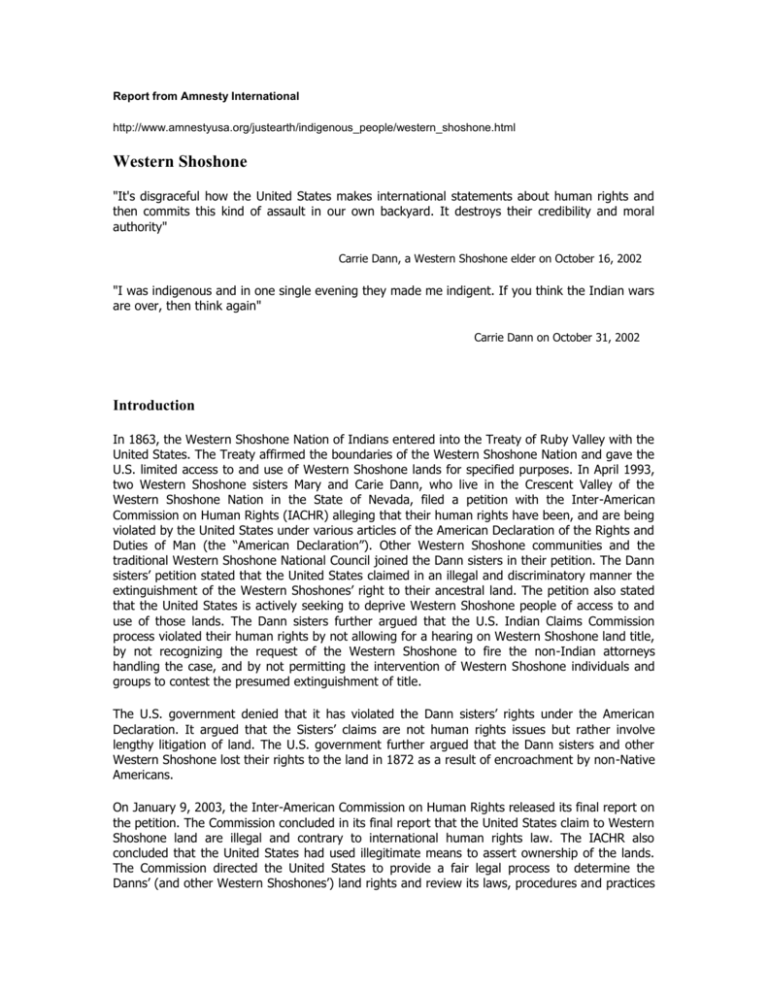
Report from Amnesty International http://www.amnestyusa.org/justearth/indigenous_people/western_shoshone.html Western Shoshone "It's disgraceful how the United States makes international statements about human rights and then commits this kind of assault in our own backyard. It destroys their credibility and moral authority" Carrie Dann, a Western Shoshone elder on October 16, 2002 "I was indigenous and in one single evening they made me indigent. If you think the Indian wars are over, then think again" Carrie Dann on October 31, 2002 Introduction In 1863, the Western Shoshone Nation of Indians entered into the Treaty of Ruby Valley with the United States. The Treaty affirmed the boundaries of the Western Shoshone Nation and gave the U.S. limited access to and use of Western Shoshone lands for specified purposes. In April 1993, two Western Shoshone sisters Mary and Carie Dann, who live in the Crescent Valley of the Western Shoshone Nation in the State of Nevada, filed a petition with the Inter-American Commission on Human Rights (IACHR) alleging that their human rights have been, and are being violated by the United States under various articles of the American Declaration of the Rights and Duties of Man (the “American Declaration”). Other Western Shoshone communities and the traditional Western Shoshone National Council joined the Dann sisters in their petition. The Dann sisters’ petition stated that the United States claimed in an illegal and discriminatory manner the extinguishment of the Western Shoshones’ right to their ancestral land. The petition also stated that the United States is actively seeking to deprive Western Shoshone people of access to and use of those lands. The Dann sisters further argued that the U.S. Indian Claims Commission process violated their human rights by not allowing for a hearing on Western Shoshone land title, by not recognizing the request of the Western Shoshone to fire the non-Indian attorneys handling the case, and by not permitting the intervention of Western Shoshone individuals and groups to contest the presumed extinguishment of title. The U.S. government denied that it has violated the Dann sisters’ rights under the American Declaration. It argued that the Sisters’ claims are not human rights issues but rather involve lengthy litigation of land. The U.S. government further argued that the Dann sisters and other Western Shoshone lost their rights to the land in 1872 as a result of encroachment by non-Native Americans. On January 9, 2003, the Inter-American Commission on Human Rights released its final report on the petition. The Commission concluded in its final report that the United States claim to Western Shoshone land are illegal and contrary to international human rights law. The IACHR also concluded that the United States had used illegitimate means to assert ownership of the lands. The Commission directed the United States to provide a fair legal process to determine the Danns’ (and other Western Shoshones’) land rights and review its laws, procedures and practices to ensure that U.S. policies governing the property rights of Indigenous peoples comply with the American Declaration on the Rights and Duties of Man. Amnesty takes no side in disputes over land but the organization is deeply concerned by IACHR’s report that the human rights of the Western Shoshone are being violated by the United States. Amnesty is also concerned about the alleged violation against them, in particular their rights to equality before the law, to be free of discrimination, to fair trial and to property. The way in which the United States has handled the land claim has been found by the Inter-American Commission on Human Rights (IACHR) to be in violation of international law. Background Following WWII, in 1946 Congress passed the Indian Claims Commission Act, which permitted American Indians to sue the United States for the wrongful taking of their lands. The act established the Indian Claims Commission (ICC) as a quasi-judicial body charged with investigating each claim brought before it. On October 16, 1962, the ICC issued a 30 page “Findings of Fact,” in the Western Shoshone case. Out of the 30 pages, only some 39 sentences specifically pertained to the Western Shoshones. The “Findings” stated in part “that Indian title to the…Western Shoshone land was extinguished by the gradual encroachment of settlers and others and by the acquisition, disposition, or taking of said lands by the United States for its own use and benefit or that of its citizens.” However, a close reading of the 39 sentences of the ICC “Findings of Fact” having to do with the Western Shoshones reveals no historically documented basis for the ICC’s conclusion. Because the ICC did not base its “Findings” on historical documentation, the ICC further stated that, “the Commission may not now definitely set the date of acquisition of these lands by the United States.” In 1966, the ICC issued an opinion accepting an arbitrary “date of valuation” that had been selected by non-Indian attorneys, without the participation or consent of the Western Shoshone people. For purposes of compensation, the ICC certified July 1, 1872 as the “date of valuation,” and the total area for which the Western Shoshones were to be compensated for the supposed “taking” of their lands was determined to be 24 million acres. This amount of acreage was based on a map created by the ICC’s expert witness, anthropologist Dr. Omer C. Stewart. There are discrepancies between Dr. Stewart’s map and the Western Shoshone Sacred Lands Association assessment of 62 million acres, based on the places named in the 1863 Treaty of Ruby Valley. Furthermore, Dr. Stewart never mentioned consulting with any Western Shoshone while preparing his map. In 1979, despite Western Shoshone attempts to stop the proceedings, the United States Court of Claims awarded less than $27 million – the 1872 value, from the ICC’s point of view, without interest – to the tribe to be held by the Interior Department. The award amount has since grown to approximately $140 million. The value of the Western Shoshone land, however, is now valued between $250 and $1,000 an acre. The United States vs the Dann Sisters In 1974, the United States government sued Mary and Carrie Dann for trespassing. The United States government accused the two Western Shoshone elders of grazing cattle on U.S. public land without having obtained a federal permit. The Dann’s response was that they were grazing their cattle on Western Shoshone land as recognized in the Treaty of Ruby Valley. In 1984, the dispute ultimately ended up before the U.S. Supreme Court. And in 1985 the Court handed down its decision in U.S. v. Dann. The Court held that the Western Shoshone had been paid because the government had placed funds into a trust account in the name of the Western Shoshone, and that such payment barred the Dann sisters from raising Western Shoshone title as a defense against the federal government’s trespass charges. The underlying basis of the Court’s decision is that American Indians are classified under the U.S. Indian law system to be “wards” of the United States government. Thus, the Court deemed that the U.S. federal government could pay itself as the Indians “guardian” and say that therefore the Indians had been paid. Importantly, the Supreme Court based its ruling in U.S. v. Dann on the definition of “finality” found in Section 22(a) of the Indian Claims Commission Act, part of which required an ICC report to be filed with Congress. However, what the Court did not realize at the time of its decision is that the Indian Claims Commission had never filed a report with Congress as required by statute, and that “finality” in the Western Shoshone case had never been achieved by the ICC in the Western Shoshone case. As a result of the ICC process, the monetary “award” for the purported extinguishments of Western Shoshone title (nearly $140 million dollars), is still held in trust by the U.S. Treasury because the Western Shoshone have refused to accept money for land they argue was never sold, ceded, lost or abandoned. The UN and Inter-American Human Rights Commission Weighs in on the Dispute In August 2001, the United Nations Committee on the Elimination of Racial Discrimination noted the persistence of discrimination and destructive policies by the U.S. against Indigenous peoples and expressed specific concern with regard to the situation of the Western Shoshone. On January 9, 2003, the Inter-American Commission on Human Rights released its final report regarding the long-standing conflict between the United States and the Western Shoshone (the petition was filed by Mary and Carrie Dann of the Dann Band in 1993. The Western Shoshone National Council, Yomba Shoshone, Duckwater Shoshone and Ely Shoshone Tribes filed amicus curiae briefs in support of the petition). After an exhaustive review, the Commission concluded that the United States has been violating the human rights of the Western Shoshone, including the right to equality before the law, the right to judicial protection and due process, and the right to property. The ruling was highly critical of the Indian Claims Commission’s handling of the Dann Sisters’ case. It is the first time that the U.S. has been formally found in violation of international human rights in its treatment of Indigenous peoples within its border. The U.S. State Department has yet to indicate whether it will comply with the Commission’s decisions. In its response to the Commission’s preliminary finding, the U.S. claimed that the Dann’s claims had been “fully and fairly” litigated in domestic courts. The Commission’s final report rejected this claim and reissued its call on the U.S. to give the Dann sisters a full and fair hearing on the legal merits of Western Shoshone land claims. The Commission also affirmed that the assertion of title by the United States to lands claimed by the Western Shoshone violates international human rights law because the Indian Claims Commission proceedings lacked adequate due process protections and were discriminatory. The Commission also found that Articles XVIII and XXIII (rights to judicial protection and property) require that any determination of Indigenous peoples’ interests in land must be based upon a process of fully informed and mutual consent on the part of the Indigenous community as a whole – that is, members must 1) be fully and accurately informed, 2) have an effective opportunity to participate as individuals and as collectives. The Commission recommended that in order for the United States to come into compliance with its human rights obligations, it must seek an effective remedy for the Western Shoshone, either legislatively or otherwise, and it must review its laws, policies and procedures to ensure that the property rights of Indigenous persons are determined in accordance with the rights established in the American Declaration. The Western Shoshone and groups that represent them have questioned why would the U.S. want Western Shoshone land. One reason may be that once the Treaty of Ruby Valley was signed, gold mining operations spread across the landscape. With the repression of Western Shoshone resistance and independence, the United States saw fit to facilitate the development of Western Shoshone lands for their mineral potential to the fullest extent possible. More than one hundred years of government policy in subsidizing and promoting the mining industry has led to a modern mining boom unlike any in world history. Western Shoshone lands now account for the majority of gold produced within the United States and almost 10 percent of world production. The scale of mining operations in the area is unprecedented and could leave a legacy of environmental impacts for centuries into the future. Even after two requests, one in 1993 and the other in 1998, by the Inter-American Commission on Human Rights to stay its intention to impound Dann livestock until the case is resolved, the U.S. continues to threaten the livelihood of the Danns. In September 2002, 40 agents from the Bureau of Land Management, heavily armed and accompanied by helicopters, confiscated 232 cattle off the Dann ranch. The cattle (about half of the family herd) was later sold off at auction, bringing in a mere $24,444 of the $3 million the government claims the Dann sisters owe in grazing fees dating back since the 1970s. In early January 2003, the BLM announced it would round up the nearly 1,000 of the Danns horses. In response to the threat of a roundup, the Western Shoshone National Council (WSNC) created the Western Shoshone International Goodwill Horse Program to which the Dann sisters are donating their horses. The purpose of the program is to promote economic development opportunities for Indian nations through horse management and gentling programs and to strengthen youth empowerment activities. Though the horses will be used to benefit the Western Shoshone peoples rather than coming under control of the BLM, the Dann sisters are still suffering a major blow to their economic survival. In a legislative bid to legitimize the U.S. government’s claim to the land, Senator Harry Reid (DNev.) sponsored Senate Bill 958, the Western Shoshone Claims Distribution Act, that would distribute the almost $140 million settlement. The Dann sisters, along with other Western Shoshone, oppose the bill, which they believe will thwart their challenges to land rights and will open up the land to even more gold mining. On November 16, 2002, a day after being passed in the Senate, the bill died in the House of Representatives as the 107th Congress ended. However, the 108th Congress has seen the reintroduction of the bill into the House (HR 884) by Representative Jim Gibbons of Nevada. The bill is opposed by traditional Western Shoshone as well as a majority of the Western Shoshone Indian Reorganization Act governments who were left out of the discussion about whether to distribute this money - a flagrant violation of the longstanding policy of the U.S. to respect Indian sovereignty and government-to-government relations. The Western Shoshones did not cede their lands to the United States and are still fighting for the recognition of their rights to their ancestral homeland. References: LeDuff, Charlie. October 31, 2002. Range war in Nevada pits U.S. against 2 Shoshone sisters. The New York Times. Page A16. Sewall, Christopher. June 1999. Digging holes in the spirit: Gold mining and the survival of the Western Shoshone Nation. Inkworks Press.
